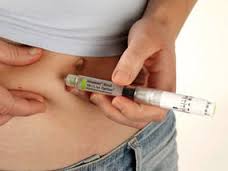The primary and immediate problem we confront with T1D is the absence of insulin.
The solution to the problem is to inject insulin subcutaneously.
In a normal body the insulin is introduced through a duct in the pancreas directly into the digestive track. A T1D injects with a needle or an insulin pump a bit deeper than under the skin but not in the muscle and, God Forbid, not into the vein.
The solution enables the body to survive.
Now we are left with a very difficult challenge.
We want to attain normal and balanced blood sugar with this synthetically manufactured insulin that is going into the body in an abnormal manner.
Not an easy task.
Definitely a 10.0+ on the degree of difficulty scale.
The solution is not easy.
However, it is doable.
Injected insulin works differently than human insulin.
It takes time to take affect.
It surges.
Peaks.
It wanes.
It’s gone.
Because normal blood sugar is between 75 and 120 mg/dl we must be aware of not taking too much insulin.
If normal was 0 then it would be an easier task.
A balance must be struck here.
A normal body is always seeking balance (homeostasis) in all of its systems.
It does this in the system we are inquiring in to by secreting a “basal” dosage of insulin at all times. It is kind of like flying a plane. Normal functioning maintains an altitude of 80 feet and rarely goes above 140. So the accelerator (insulin) is always on. In a normal body this is done unconsciously. It recognizes when food has been eaten and secrets just enough insulin to cover it and keep the blood sugar level in the normal range. It is a perpetual motion system. It is on continuous auto pilot. Type 1 Diabetes means that the accelerator is gone. It’s replacement is not our own, but rather, synthetically produced and a bit different. Our altimeter is broken. A blood sugar monitor takes its place. A normal body is continuously monitoring altitude and making the appropriate corrections . We must manually apply the “new” and foreign accelerator and check our rudimentary altimeter in order to ensure we are “in range.” Multiple testing is sometimes required to know if we are trending down or up.
Talk about flying blind?
Continuous Glucose Monitors (CGM’s) have recently been invented and provide a blood sugar result every five minutes.
I have a CGM and I recommend getting one.
I will talk more about CGM’s later.
The Transforming Diabetes process requires, on average, 10 finger prick tests throughout the day.
Food is the fuel. A normal body “handles” the food that is digested and maintains blood sugar balance. Because we do not produce insulin we must match the insulin we inject with the food we eat. This presents a myriad of issues. Glucose in the blood comes from Carbohydrate grams and fat grams. Every body is different so the amount of insulin required is different. And it is not an exact science. I will be getting more into insulin dosage and food later in the process.
Physical exertion burns glucose. Less insulin is required.
Other hormones and chemical reactions in the body affect the efficiency of insulin and blood sugar levels. For example, under stress adrenaline is produced and this raises blood sugar.
Illnesses like the common cold reduces the efficiency of insulin. Being sick may require an increase in insulin by 40 to 100%. It depends. As one gets better this requirement will ease back.
When blood sugar levels go high (above 250) insulin works differently.
This is not a condition in which you can “take your medicine” and watch what you eat and otherwise live a normal life.
You may be able to survive with this attitude but it will be far from normal.
Your mission, should you decide to accept it, is to re-create this damaged perpetual motion system knowing it can never be perfect.
It requires attention 24/7.
Our goals is to attain A1C results below 7.0.
If you are ready let’s get to it.
Exercises:
1.) Do some research on the cause of diabetes and the invention of insulin.
2.) You need to know how many carbohydrates and fat grams you are ingesting on a daily basis. Educate yourself if you don’t know how to do this. There are books that you can buy that provide you with this information.
3.) Document your daily dose of insulin. If you are Type 1 I know that the best way to deliver insulin is via an insulin pump. I understand that there are reasons and excuses to be taking injections, however, I encourage you to at least check out the pump. If you are taking injections you are probably on Lantus for your basal and a short acting insulin to bolus for food and corrections. If you are on a different insulin regimen then I am not sure this process will be of much help. Write down your basal rate, your total daily basal dose, your carbohydrate to insulin ratio, your total bolus dose for the day, your total daily dose (basal and bolus combined) and your Insulin Sensitivity Factor (ISF) also known as your correction number or how many points does your blood sugar drop with 1 unit of insulin. If you don’t know or are not clear about what basal, bolus, ISF or correction means you will be introduced to them in the next few posts. Hang in there.
Yoga Practice:
Prior to sitting for your morning meditation begin by standing, feet hip width apart, knees slightly bent, pelvic floor tucked a bit under. Lift up through your midsection, push out in your sternum (heart) area, extend your neck. Your chin should be perpendicular to the floor. Energetically, extend the crown of your head upward. Very slowly and with conscious intent and awareness extend you arms out until they are perpendicular to the floor. Pause here for at least 10 seconds. Take a deep breath in through the nose and slowly continue and extend your arms all the way upright. Bend your knees a bit more and sink down, Stay here for 30 seconds. Take a deep breath and bring your knees back to their original position by straightening your legs. As slow as possible begin to lower your arms to your side. The slower the better. Take another deep breath. Exhale. Sit and begin your meditation.
In the next post we will breakdown the component parts of the system we must build. Remember, your attitude throughout this process is one of 100% acceptance and commitment. Cultivate and maintain this attitude as best as you can. You may move on to the next post at anytime.

